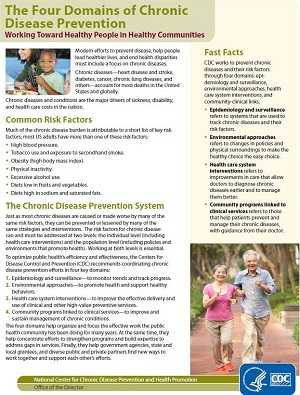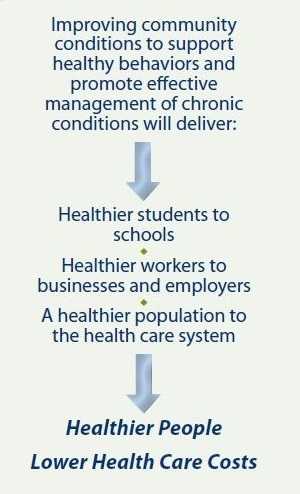The Four Domains of Chronic Disease Prevention
Working Toward Healthy People in Healthy Communities
Modern efforts to prevent disease, help people lead healthier lives, and end health disparities must include a focus on chronic diseases.
Chronic diseases—heart disease and stroke, type 2 diabetes, cancer, chronic lung diseases, and others—account for most deaths in the United States and globally.
Chronic diseases and conditions are the major drivers of sickness, disability, and health care costs in the nation.
Common Risk Factors
Much of the chronic disease burden is attributable to a short list of key risk factors; most US adults have more than one of these risk factors:
- High blood pressure.
- Tobacco use and exposure to secondhand smoke.
- Obesity (high body mass index).
- Physical inactivity.
- Excessive alcohol use.
- Diets low in fruits and vegetables.
- Diets high in sodium and saturated fats.
The Chronic Disease Prevention System
Just as most chronic diseases are caused or made worse by many of the same risk factors, they can be prevented or lessened by many of the same strategies and interventions. The risk factors for chronic disease can and must be addressed at two levels: the individual level (including health care interventions) and the population level (including policies and environments that promote health). Working at both levels is essential. To optimize public health’s efficiency and effectiveness, the Centers for Disease Control and Prevention (CDC) recommends coordinating chronic disease prevention efforts in four key domains:
- Epidemiology and surveillance—to monitor trends and track progress.
- Environmental approaches—to promote health and support healthy behaviors.
- Health care system interventions—to improve the effective delivery and use of clinical and other high-value preventive services.
- Community programs linked to clinical services—to improve and sustain management of chronic conditions.
The four domains help organize and focus the effective work the public health community has been doing for many years. At the same time, they help concentrate efforts to strengthen programs and build expertise to address gaps in services. Finally, they help government agencies, state and local grantees, and diverse public and private partners find new ways to work together and support each other’s efforts.
The four domains focus on strategies that
- Collectively address the behaviors and other risk factors that can cause chronic diseases.
- Work to simultaneously prevent and control multiple diseases and conditions.
- Reach more people by strengthening systems and environments to support health.
- Link community and health care efforts to prevent and control disease.
In sum, the four domains highlight shared strategies and opportunities to make real health improvements across a range of diseases, conditions, and risk factors to improve the health and quality of life of millions of Americans. This coordinated approach to preventing chronic diseases and promoting health can help achieve NCCDPHP’s vision of healthy people in healthy communities.
Domain 1 : Epidemiology and Surveillance
Epidemiology and surveillance provide essential data to define and prioritize public health problems, identify populations most affected, guide solutions, and monitor progress. Insights can be used to educate decision makers and the public about
- The high rates of death and disability and the high health care costs associated with chronic diseases.
- Actions being taken by the public health community and its partners to prevent and control chronic diseases.
- Successes in preventing and controlling chronic diseases.
- Unmet needs and priorities in addressing chronic diseases.
Related Materials
Fast Facts
CDC works to prevent chronic diseases and their risk factors through four domains: epidemiology and surveillance, environmental approaches, health care system interventions, and community-clinical links.
- Epidemiology and surveillance refers to systems that are used to track chronic diseases and their risk factors.
- Environmental approaches refers to changes in policies and physical surroundings to make the healthy choice the easy choice.
- Health care system interventions refers to improvements in care that allow doctors to diagnose chronic diseases earlier and to manage them better.
- Community programs linked to clinical services refers to those that help patients prevent and manage their chronic diseases, with guidance from their doctor.

Epidemiology and Surveillance in Action
- Track chronic diseases and their risk factors and share the information in easy-to-use formats. Ensure coordination among multiple data systems, including behavioral risk factor surveys (e.g., the Behavioral Risk Factor Surveillance System), birth and death certificates (from the National Vital Statistics System), registries of cancer cases and deaths (e.g., the National Program of Cancer Registries), and health care data (e.g., from Medicare data sets).
- Monitor social and environmental factors that influence health, as well as policies that affect chronic diseases, such as those related to smoke-free air, access to healthy foods, and community water fluoridation.
- Conduct surveillance of health care preventive services, such as cancer screening, the “ABCS” of heart disease and stroke prevention (Aspirin use, Blood pressure and Cholesterol control, and Smoking cessation), and measures of diabetes control (e.g., hemoglobin A1C) and obesity (e.g., body mass index).
- Leverage health information technology to improve efficiency and timeliness of public health surveillance (e.g., use new US meaningful-use standards to speed reporting to state cancer registries).

Domain 2: Environmental Approaches
Environmental approaches promote health and support healthy behaviors across the nation, in states and communities, and in settings such as schools, child care programs, work sites, and businesses. Approaches that change the environment reach more people, are more cost efficient, and are more likely to have a lasting effect on population health.
Environmental Approaches in Action
- Policies that change the context and make healthy lifestyles easier:
- Comprehensive smoke-free air laws that cover all workplaces, restaurants, and bars, protecting nonsmokers from secondhand tobacco smoke.
- Bans on flavored cigarettes, to make smoking less attractive to youth.
- Bans on artificial trans fats, eliminating a cardiotoxin from the food supply.
- Increases in the number of community water systems that have the best level of fluoride to prevent cavities.
- Price increases for unhealthy products (e.g., tobacco, alcohol, and high-calorie, low-nutrition foods and drinks) to reflect the medical and societal costs of their use.
- Changes to social and physical environments that make healthy choices easier, safer, cheaper, and more convenient:
- Community design that encourages walking and biking.
- More schools that offer more high-quality physical education, and child care programs that follow national physical activity standards.
- More access to healthy foods and beverages (e.g., full-service groceries and farmers markets in underserved areas, healthier menu items in restaurants).
Domain 3: Health Care System Interventions
Health care system interventions increase the use and improve the quality of clinical and other preventive services. These services prevent or enable early detection of disease, reduce risk factors, and manage complications. Interventions that increase access to and build demand for quality preventive services, such as the National Breast and Cervical Cancer Early Detection Program, also reduce population health disparities.
Health Care System Interventions in Action
- The Affordable Care Act, US meaningful-use regulations, and other health reform efforts offer opportunities to speed progress by creating ways to
- Expand population coverage.
- Require coverage of effective clinical preventive services.
- Improve the organization of and payment for care.
- Involve a larger number and broader range of health professionals in delivering care.
- Increase use of health information technology and tools (e.g., reminders and clinical decision support).
- Increase measurement and reporting of successes and shortfalls.
- Governmental and community public health organizations can foster better health system use through approaches that
- Define high-impact services and priorities.
- Conduct surveillance of high-priority health outcomes.
- Remove barriers to access to help ensure delivery of care to hardest-to-reach populations.
Domain 4: Community Programs Linked to Clinical Services
Strategies that link community and clinical services help ensure that people with or at high risk of chronic diseases have access to the resources they need to prevent or manage these diseases.
In turn, people can improve their quality of life, delay the onset or progression of disease, avoid complications, and reduce the need for more health care. Improved links between the community and clinical settings offer community delivery of proven programs, to which patients may be referred by a clinician, with third-party payments to community organizations and lay providers.
Community-Clinical Links in Action
- Increase the use of effective community interventions—such as chronic disease self-management programs, the National Diabetes Prevention Program, and smoking cessation services—by making them widely available, ensuring that doctors refer their patients to them, and helping to ensure that they are covered by health insurance.
- Link existing public health services, such as tobacco quitlines, to health care systems.
- Establish partnerships with hospitals and health care providers to improve community and population health through use of community benefit investments and advocacy.
- Encourage a broader spectrum of health care workers—including pharmacists, patient navigators, and community health workers—to help people manage their own health.
- Use education and outreach to more fully engage the public in its own health care.
CDC’s Chronic Disease Prevention System
What We Do
- Provide leadership and technical assistance
- Monitor chronic diseases, conditions, and risk factors
- Conduct and translate research and evaluation to enhance prevention
- Engage in health communication
- Develop sound public health policies
- Implement prevention strategies
Who We Work With
- State, tribal, territorial, and local governments
- National, state, and local nongovernmental organizations
Where We Do It
- Communities
- Workplaces
- Schools and academic institutions
- Health care settings
- Child care settings
- Faith organizations
- Homes
How We Do It â”’ The Four Domains
Epidemiology and Surveillance
Provide data and conduct research to guide, prioritize, deliver, and monitor programs and population health
Environmental Approaches
Make healthy behaviors easier and more convenient for more people
Health Care System Interventions
Improve delivery and use of quality clinical services to prevent disease, detect diseases early, and manage risk factors
Community-Clinical Links
Ensure that people with or at high risk of chronic diseases have access to quality community resources to best manage their conditions
Why We Do It
- Healthier environments
- Healthier behaviors
- Greater health equity
- Increased productivity
- Lower health care costs
- Increased life expectancy
- Improved quality of life
What We Achieve
- Less tobacco use
- Less obesity
- Less heart disease and stroke
- Less cancer
- Less diabetes
- Less arthritis
- More physical activity
- Better nutrition
- Better oral health
- Healthier mothers and babies
- Healthier kids
- Page last reviewed: December 29, 2015
- Page last updated: December 29, 2015
- Content source:



 ShareCompartir
ShareCompartir

